If you want to market smarter or sell smarter, you have to be able to answer this million-dollar question,
“Why do customers buy?”
So, if you ask your team or your clients that why people buy from them. The answer they will be telling you is something about the product or service.
They gonna say:
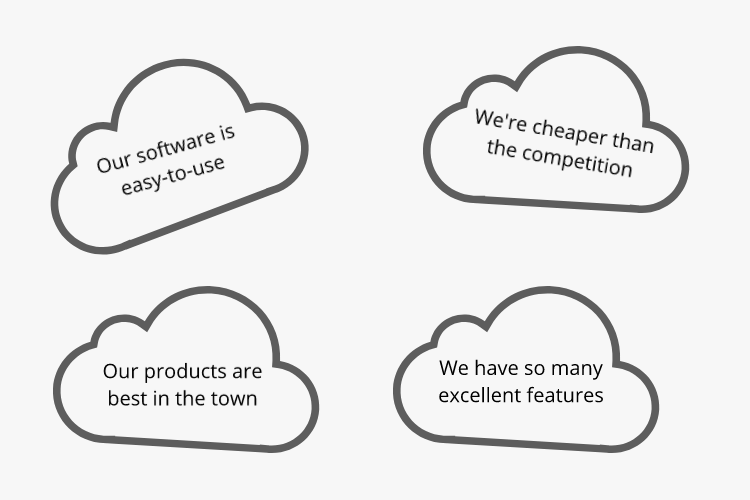
All of the above things might be true, but these are not the answers that you need.
If you want to get big marketing results, the clients that are bragging about; then you need to just focus on the product and need to better understand your customers.
So how do we do that?
For a long time marketers thought this is the way:
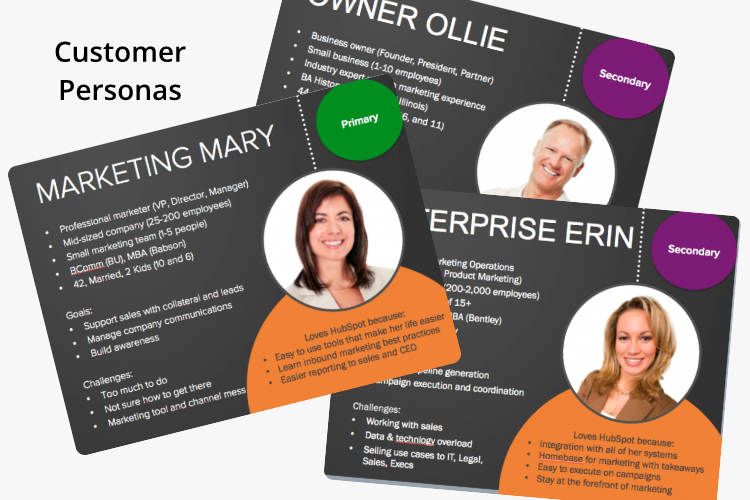
You go and create these customer personas on each customer segment like the above one in HubSpot.
The goal is always the same – the more we know about the customers, the better we can market to them. In theory, this makes sense; data-driven decision-making is a lot better than the old marketing days- the days where marketing was led by gut instincts.
So marketers’ said,
Hey, we need more customer data! Please give us more customer data.
And yes of course, company’s were happy to oblige. A lot of businesses were setup just to give marketers more and more data.
Today, we have an astronomical amount of data about our customers. We know who they are –
- We know their demographics stuff – age, income, location, etc.
- We know their firmographics stuff – job titles, the industry they work at, etc.
- We know their behavior – what they are searching for, what they are clicking on, where they are spending their money, where they are spending their time etc.
- And some companies even promise to tell how our customers feel by analyzing the words they use.
We are drowning with customer data, but

This is the major problem. Right?
According to ProfitWell,
It costs 50% more to acquire a customer today than it did 5 years ago.
And that is depressing.
The problem is that we have so much customer data but it doesn’t tell us what we desperately need to know. It doesn’t tell us WHY CUSTOMERS BUY?
Let’s look at an example:
I recently bought a new alarm clock.
I am a 27-year-old man. I live in Bengaluru, India. I love playing cricket. I love drinking coke and hear business podcast. I am active on a lot of social media channels, follow a lot of influencers. I love Odia food.
So, these are all attributes about WHO I AM. And this could be very useful when targeting more people like me.
But even if you come in front of me, WHAT YOU GONNA SAY TO ME?
After all none of these explains, WHY DID I BUY AN ALARM CLOCK?
So again back to the question,
“Why do customers really buy?”
And more importantly for us marketers “How can we convince people to buy what we are selling.“
During my initial days of Marketing, these questions used to keep me up at night. I felt like I was drowning in customer data and still starving for the right answers.
And then I discovered this guy – Clayton Christensen. He is widely considered the world’s foremost expert in innovation.
According to Clayton,
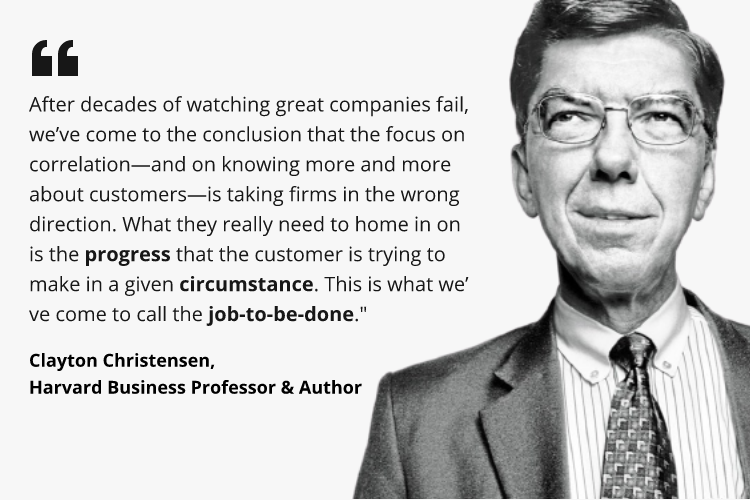
Jobs-to-be-done is a theory for understanding what motivates people to buy and use new things
The theory is pretty simple.
People buy things because they want to make their life better. They want progress where they are struggling as there are obstacles in their way. So they hire products to help them to get the Job-to-be-done.
If the product works well, they are happy. Then they are going to keep using it. They gonna tell their friends how great it is. But if it doesn’t work well then they gonna fire it.
This way of framing why people buy things, they are just the “Aha! moment” for me.
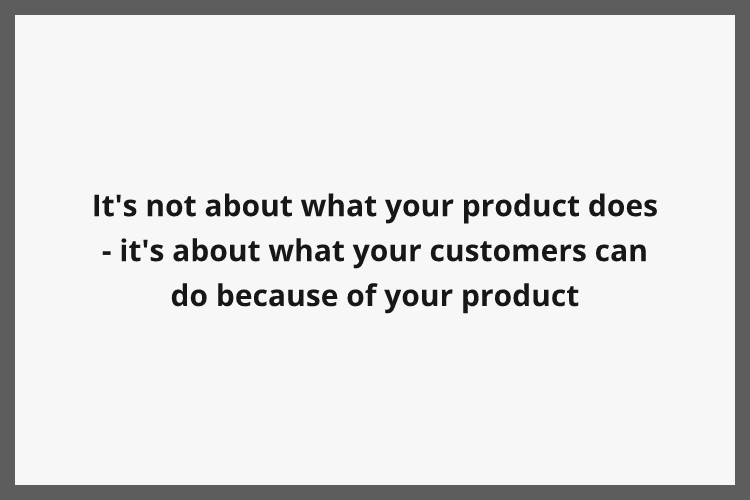
It is an important distinction which a lot of marketers miss.
Upgrade your user – not your product. You don’t build better cameras. You build better photographers.
– Kathy Sierra, Entrepreneur & Game Developer

And so who would have thought that all of the technologies that we have today are just to make ourselves a better version. In this case, it’s about the best-known photographers nowadays around the world use a “mobile phone” as their tool choice rather than a DSLR.
Let’s return to my alarm clock example.
So when I bought my new alarm clock, technically what I was buying is this thing:
An Alarm Clock
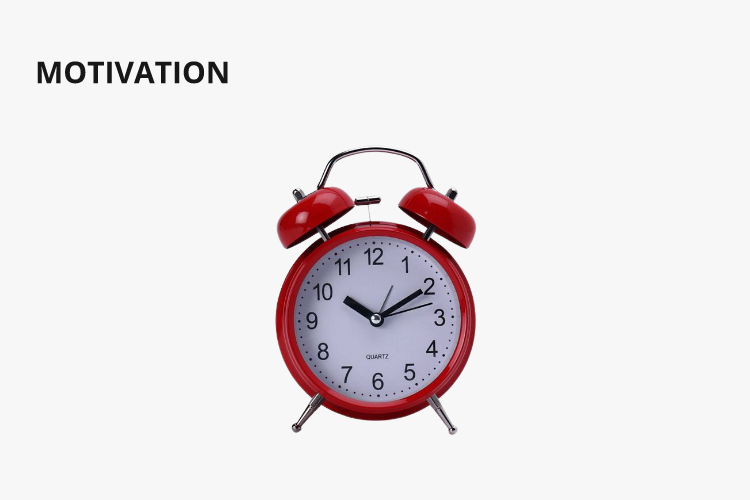
But what I wanted was this thing:
To become fit for which I need to work out

I had made a birthday resolution to get fit and I hired my alarm clock to become the better version of myself.
The kind of person who wakes up early in the morning and goes for a run.
In the past, I used my smartphone, like an alarm clock but that didn’t work fine. When I wanted to get up earlier, the phone became a problem. My phone sitting up in my next hand before going to bed, I end up scrolling social media on the bed rather than going to sleep on time.
And when the alarm rang in the morning, I was drowsy and it was way too easy to hit the snooze button and get back to bed.

I wanted something that would not distract me and push me out of the bed in the morning.

This new alarm clock doesn’t have a snooze button which is a huge plus point. And it’s not connected to the internet so I can’t scroll the feed at night.
What it does have, is a loud bell that is so jarring that it nearly gives me a heart attack every time it is on. So, that makes a way harder and I can’t just roll over and get back to sleep.
So now you know about my situation and you understand what triggered me to buy in the first place and what job I was trying to get done?
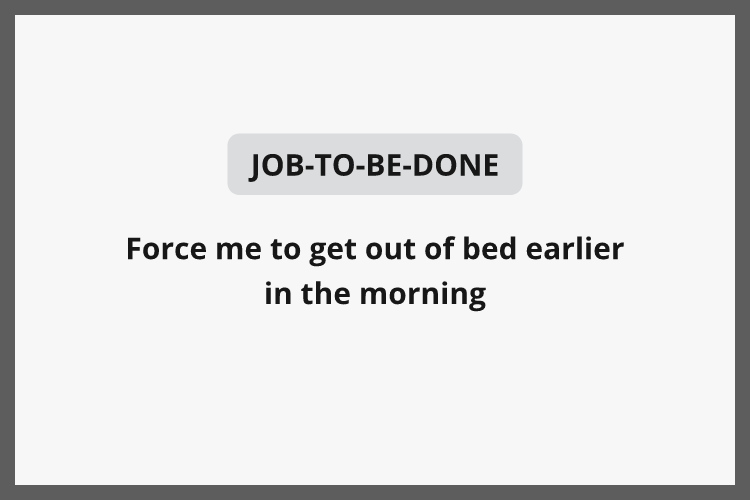
This is really neat, right?
Rather than focus on who the customer is, we should focus on when they buy things.
Jobs to be done will help you know what they want to be and when you understand your customer’s job you can see who your real competitors are.
Let’s see some other examples.
You just have the same job to do and you didn’t hire an old school alarm clock. What else would you hire?

Well if you lived in medieval times when you didn’t have an alarm clock or a mobile device, you could hire a jug of water to do your job.
Back in 1400, they didn’t have alarm clocks, no electricity. So they wanted to force themselves to get off the bed earlier, they drink a jug of water before they go to sleep. Obviously, they have to get off the bed when they have to pee.
Another way is maybe you can hire an alarm clock rug to do the job.
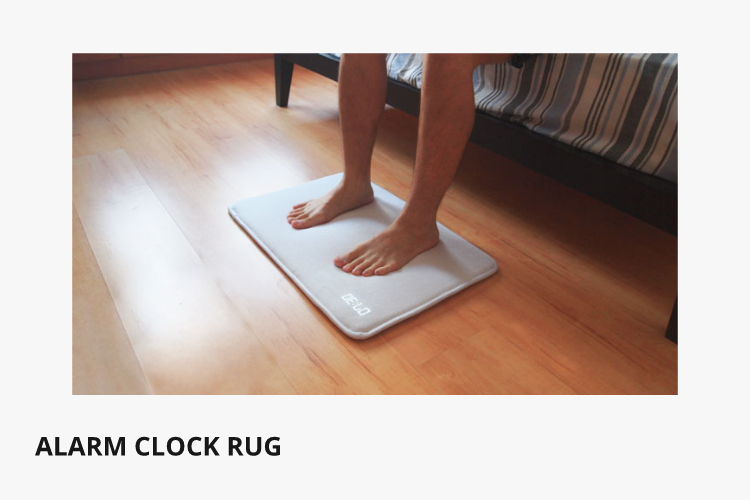
This alarm clock literally forces you to go off the bed because the only way to turn it off is by standing on it for 30 secs.
There are many ways that can force us out of the bed. Let’s dive into another situation.
Maybe your biggest problem is that you are not going to the bed on time because you keep up by scrolling throughout the night – watching Netflix or scrolling Facebook feed.
So, you may not buy an old school alarm clock, then you may buy a cellphone lockbox.
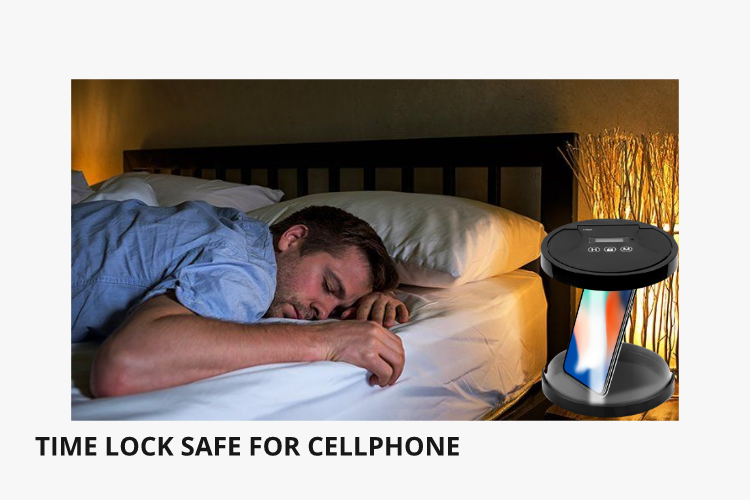
My personal top secret: #PleaseDonotTryThisAtHome I just put the following magical words in my mom’s ear, “wake me up at 6:00 am since I have an important meeting”, and she will wake me up at 5:45 am and again call and check at 6:15 am that I didn’t go back to bed.
There are a lot of different solutions you could hire to get the job done. And the one that is best for you is going to depend on the type of progress you want to make. It depends on the context of your situation.
Here’s the thing to print in mind, understand your customer’s job.
Customer jobs are complex. There are many functional, social, and emotional dimensions to consider.
When you take the time to do the above thing, I promise you it is well worth it.
A deep understanding of the jobs your customers are trying to get done gives you a clearer picture of what really drives purchasing decisions.
And this is the best part for the marketers like us. When you understand what causes people, in the beginning, looking for a new solution which I call the ‘Trigger’, You can figure out how to get in front of the right people in less crowded channels with better messages.
So, actually understanding your customers’ jobs, its gonna make your job as a marketer easier.
If you want to better understand why your customers really buy, how do you get this prized information?
You can’t just ask your customer what their job to be done is – it may be a survey or over the phone. If you also ask “what their job to be done?”, they will not be able to explain to you because they don’t think about the purchasing decision like that.
They would struggle to answer.
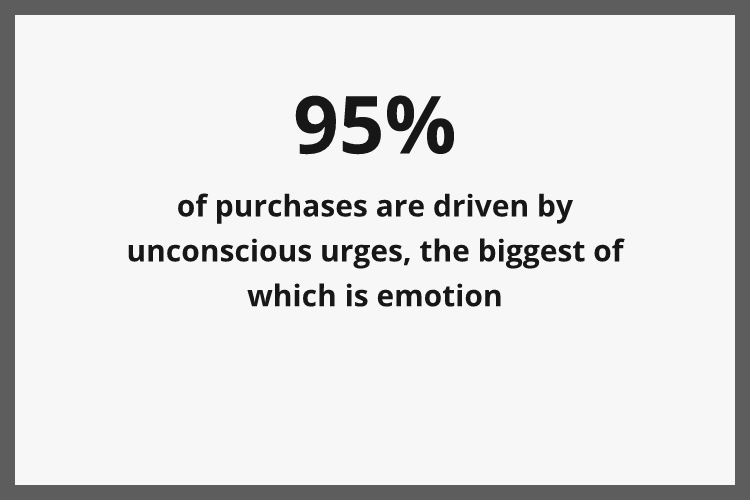
We buy for emotional reasons and we justify our decision with logic. And this is true in all purchasing decisions including B2B.
Here’s the thing if you want to market smarter, then you need to get below the surface level stuff that can be in a survey or by listening to them in a phone call, that’s the start but not enough.
What you deeply need is your customer stories that are where the deep gold is buried.
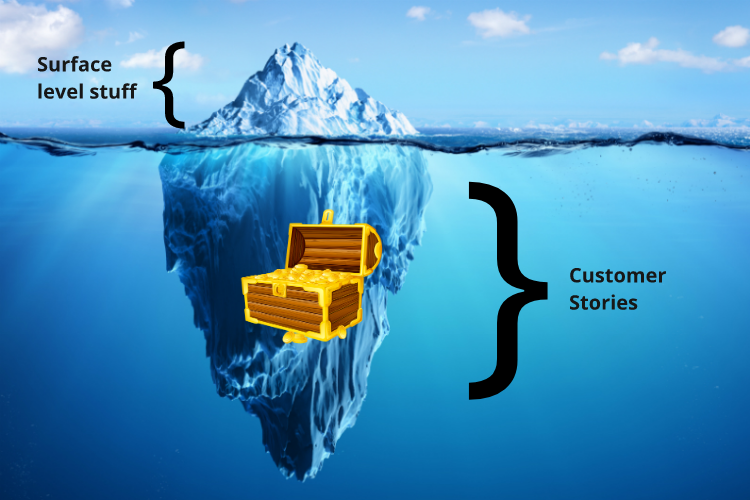
The absolute best that I have found for understanding customers is conducting 1:1 interviews with actual buyers is the best way to understand why customers really buy.
Customers that have recently bought from you are the ones that will remember the buyer’s journey.
I call this type of interview ‘clarity calls‘. Because they gonna help you to become so clear of what actually matters to customers and believe me that is so powerful.
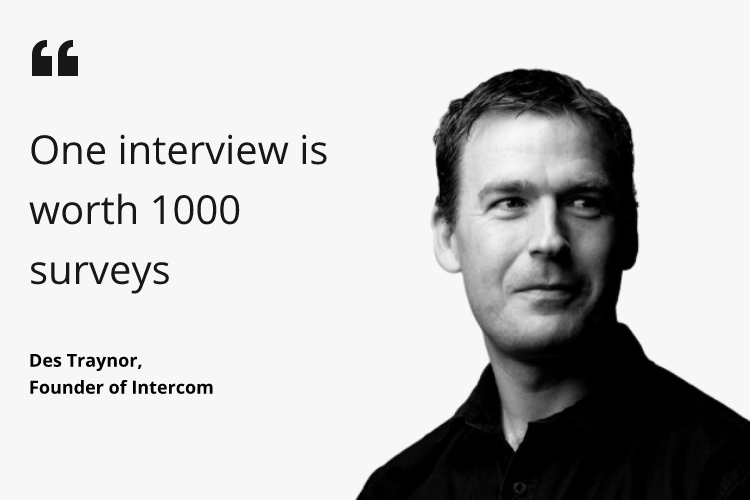
When you are doing these interviews, your number one objective is to understand the customer’s buying journey in detail.
So a typical buying journey includes some of the same steps that you are very familiar.
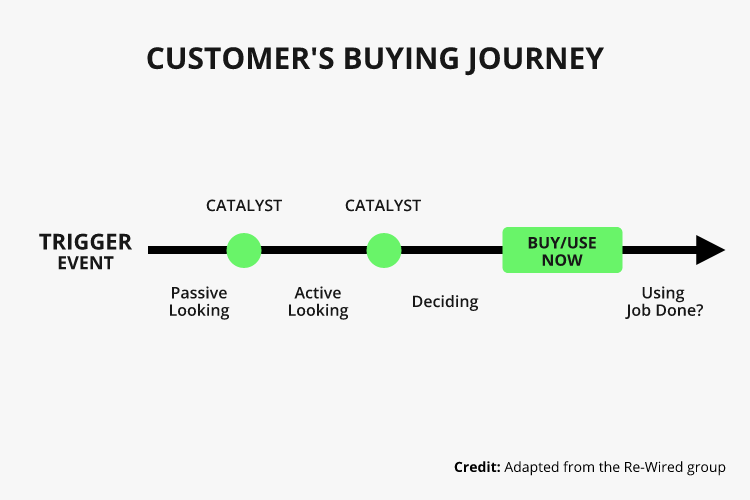
It starts with a trigger event i.e, the moment when the customer first realizes they wanted to make progress and they need a new solution. They move along the buying journey and it ends with them using your products and assuming about your product “Did it work? Did I get what I was hoping for? Did I make the progress that I hoped for? Is my job done?”
And if they are happy, they gonna stay with it and if they are not happy then they would passively look for something else to hire.
So all of these details you could gather from your customer’s buying journey, that are going to give you so much insight about how should you grow your marketing.
Many marketers are missing out on this.
They are not investing time to understand why people buy and they are not trying to see what their triggers are.
So, many marketers put all their effort at this stage of buying journey:
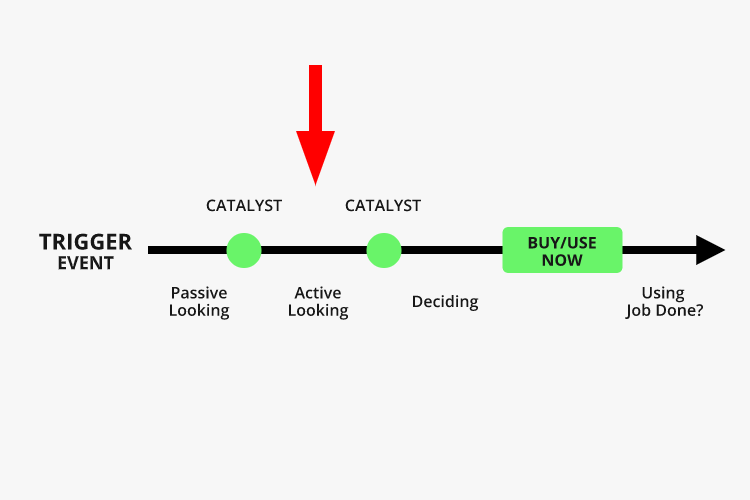
The ‘active looking’ stage is the stage where customers are actually looking for a solution like this. And marketers target these people, rather than trying to target people who are passively looking for the solution.
And that is a big mistake. So there is so much you can learn by getting in front of people sooner – the people who are actively looking for a solution like yours.
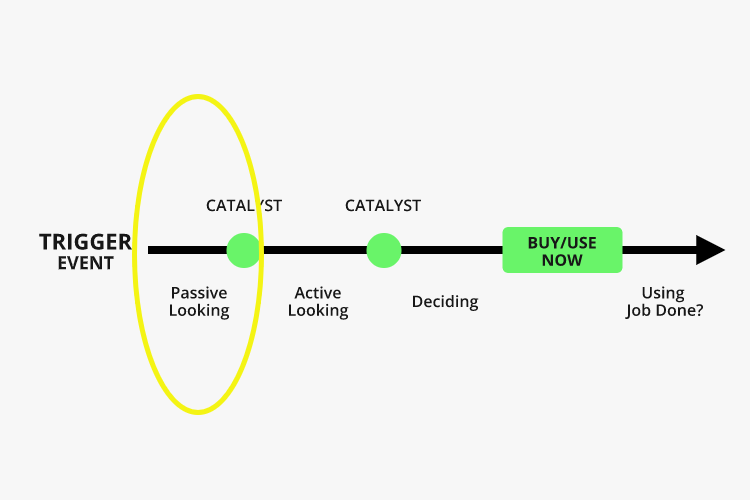
It’s just that simple right, before getting an alarm clock I will definitely search in Google for “How can I get up early?”(passive looking). Then when I know what will make me get up early i.e., in this case, is an alarm clock then I move to the second phase where I will think to buy an alarm clock (active looking).
And when I start searching for an alarm clock then the competition increases- a lot of ads everywhere (YouTube, Google, etc.). This decreases the chances of me making my product stand out. But if I am able to provide a solution and hook the customer in the passive stage then it will be a win situation for me.
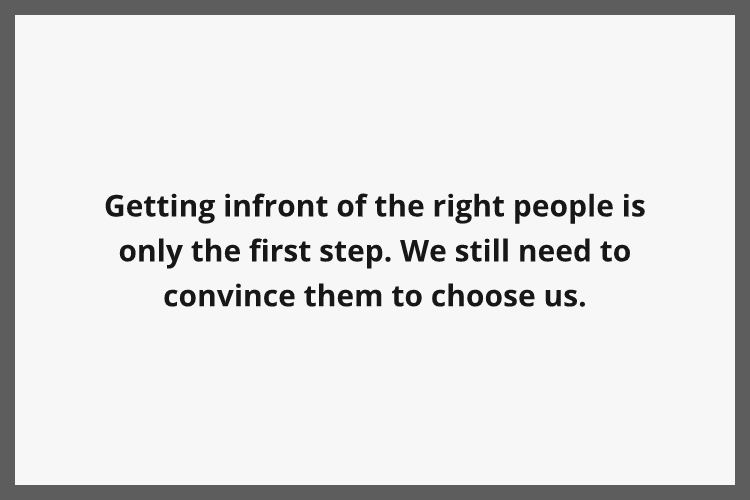
Then we have to give them a compelling reason to choose us over our competition.
Let’s see how most of the marketers are selling alarm and what customers want to buy:
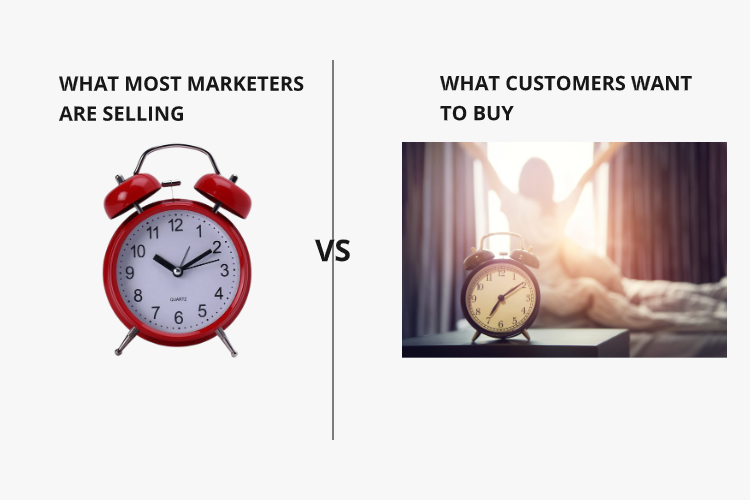
The 1st image “only alarm clock” doesn’t show the buyer’s motivation for buying an alarm clock. Now, look at the second image. Just imagine how much your product might stand out if you will include aspirational events just like this one. It lets the user feel the moment.
Now, let’s take the case of the Product description that is written for the alarm clock.
- 100% New Collection & High-Quality Nightlight Function
- Metal twin bell alarm clock.
- Material: Metal
- Color: Copper Brown.
- Feature: Ring Bell, No ticking/Silent
- Size: 4 inch x 2 inch x 4¼ inch
- Battery:2 x AA Battery(not included)
- Package: 1pc x Desk Alarm Clock Backlight vintage alarm clock to be kept bedside desk table clock for office and home
But what it should be according to a customer.
- Super loud alarm- forces you out of even the deepest sleep
- No snooze button- means no temptation to sleep in
- Keeps your phone out of the bedroom- so no midnight scrolling
- Super long-lasting battery life- no need to worry about charging
- Stylish design- looks cute on your nightstand
It’s easy to get caught up in the price-and-convenience game, but there’s more to shopper dynamics to consider.
Now that we have hopefully demystified why do customers buy and how you can identify and leverage them to reach more of the right customers, you can use this information to hone in on your target audience, which should produce good results!
Summary
- Jobs-to-be-done is a theory for understanding what motivates people to buy and use new things.
- It’s not about what your product does – it’s about what your customers can do because of your product
- Upgrade your user – not your product. You don’t build better cameras. You build better photographers
- Customer jobs are complex. There are many functional, social, and emotional dimensions to consider.
- A deep understanding of the jobs your customers are trying to get done gives you a clearer picture of what really drives purchasing decisions.
- Your number one objective as a marketer is to understand the customer’s buying journey in detail.
- Target people who are passively looking for the solution.